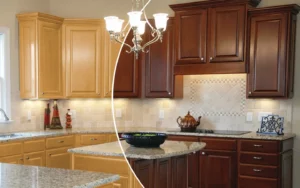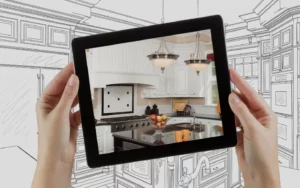Refreshing your kitchen doesn’t have to imply the cumbersome process of a comprehensive renovation. There exists a pocket-friendly and less intrusive option—kitchen cabinet refacing. Essentially, refacing revolves around sprucing up the exposed parts of the cabinet (such as doors, drawer fronts, and side panels) when they are closed. It leverages the existing framework, modifying only the cabinet’s exterior surface or ‘face’. This approach is not just budget-friendly and waste-reducing, but it also swiftly changes the kitchen’s visual appeal, leading to a striking makeover.
Understanding the Cabinet Refacing Procedure
Commencing the cabinet refacing process involves an in-depth analysis of the kitchen’s existing cabinetry structure. Cabinets need to be durable and well-constructed to endure refacing. The first step involves detaching the old doors, drawer fronts, and hardware. Subsequently, cabinet boxes undergo an inspection to identify any repairs or alterations required.

Post-inspection, the cabinet surfaces are cleaned and primed for refacing. Depending on the selected materials and design, the cabinet boxes might be painted or veneered to align with the new facade. Then, custom-built doors and drawer fronts are secured to the cabinet structure, which is succeeded by fitting new hardware such as knobs or handles.
Read more about kitchen decoration
In some scenarios, further enhancements, like crown molding, glass doors, or task lighting, can be integrated during the refacing procedure. These inclusions offer a personalized touch and amplify the kitchen’s overall functionality.
Determining the Suitability of Cabinet Refacing
Cabinet refacing is an excellent option when the existing cabinets are sturdy and well-designed and the current kitchen layout is functional and pleasing. It is the perfect solution for homeowners who desire a kitchen facelift without major structural alterations.
Conversely, if the cabinets are in disrepair or a complete kitchen layout revamp is desired, a more comprehensive kitchen remodel might be a better alternative. Likewise, cabinet refacing might not be the best choice when considering upgrading to superior cabinetry materials and construction because it does not address the quality of the cabinet boxes.

Understanding the Expenses of Cabinet Refacing
Depending on the size and number of cabinets, the selected refacing materials, and the project’s location, kitchen cabinet refacing costs can vary greatly. As per industry standards, the cost of refacing kitchen cabinets generally amounts to 50-80% of the price of new cabinet installation, making it a more economical choice than a full kitchen remodel.
However, additional elements like new drawer boxes, pull-out shelves, or premium veneers can augment the project’s overall cost. Homeowners must, therefore, strike a balance between their renovation vision and budget to ascertain if refacing is the most cost-efficient option for their kitchen renovation.
Exploring the Benefits of Kitchen Cabinet Refacing
A significant advantage of kitchen cabinet refacing is its cost-effectiveness. This process can save homeowners between 30% and 50% of the total expenditure of complete cabinet replacement. In addition, refacing causes less disruption and is generally faster than a comprehensive remodel, enabling homeowners to reclaim their kitchen space more swiftly.
Furthermore, from an ecological standpoint, refacing is a more sustainable alternative. It decreases the amount of waste destined for landfills by reusing the existing cabinetry structure. Additionally, it demands fewer new resources, contributing to a reduced carbon footprint.

Exploring the Drawbacks of Kitchen Cabinet Refacing
Despite the many merits of cabinet refacing, it might only suit some people’s needs. For instance, it needs to address functional challenges arising from the existing kitchen layout or any structural issues with the cabinets. A full replacement might be the only viable option if the cabinets are poor. Additionally, cost savings might be less noticeable if upgrading from low-end existing cabinets to a high-end finish.
Material Options for Cabinet Refacing
Cabinet refacing comes with various material options, allowing homeowners the flexibility to craft their ideal aesthetic. Affordable and versatile laminates, available in numerous colors and textures, are popular. Real wood veneers like oak, maple, and cherry bring a luxurious appearance and feel. Rigid Thermofoil (RTF), an economical and sturdy option, can effectively replicate the look of painted wood. Material selection significantly impacts aesthetics, cost, and the longevity of refaced cabinets.
Contrasting DIY Cabinet Refacing and Professional Services
While cabinet refacing is a potential DIY endeavor, it demands expertise and the correct toolkit. Errors can be expensive and eat up valuable time. Conversely, though costlier upfront, professional cabinet refacing services bring the advantage of experience and skills, ensuring the job is executed correctly on the first attempt and usually more promptly.
Care for Refaced Cabinets
Proper keeping is key to extending the lifespan of refaced cabinets. The appropriate cleaning method hinges on the material used. A soft cloth with a gentle cleaner usually takes care of most stains and spills on wood veneers and laminates. Abrasive cleaners that could scratch the surface should be avoided. Regular upkeep also involves tightening loose handles or knobs and adjusting hinges.
Designing a Cabinet Refacing Project
A well-executed cabinet refacing project is rooted in thorough planning. Homeowners should kickstart the process by evaluating their current cabinets’ condition and determining if refacing is an apt solution. Budget considerations and desired aesthetics should inform the selection of suitable materials. Precise measurements ensure a perfect fit for the new doors and drawer fronts. Whether opting for a DIY approach or professional services, meticulous planning paves the way for a successful project conclusion.

In Conclusion
Kitchen cabinet refacing is a progressive and efficient approach to kitchen renovation. It empowers homeowners to radically alter their kitchen without the expenditure, time, and inconvenience of a full remodel. Understanding the process, suitable circumstances, and cost of cabinet refacing allows homeowners to make educated decisions regarding their kitchen renovation endeavors, ensuring a result that seamlessly blends functionality with style.
KEYWORDS:
